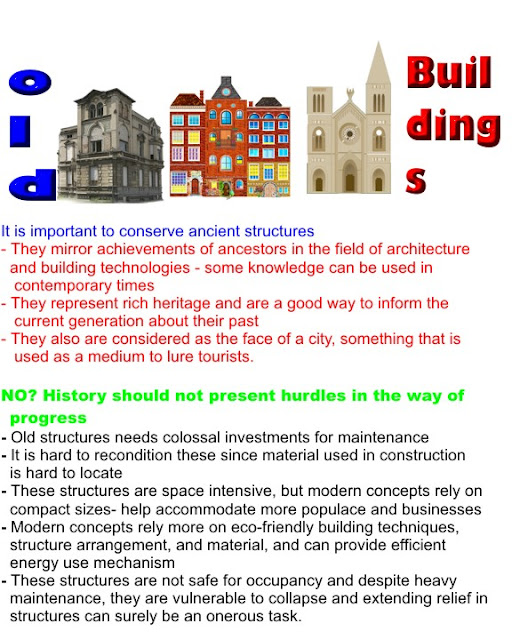Many old buildings protected by law are part of a nation’s history. Some people think they should be knocked down and replaced by news ones. How important is it to maintain old buildings? Should history stand in the way of progress?
It is important to conserve ancient structures
They mirror achievements of ancestors in the field of architecture and building technologies - some knowledge can be used in contemporary times
They represent rich heritage and are a good way to inform the current generation about their past
They also are considered as the face of a city, something that is used as a medium to lure tourists.
NO? History should not present hurdles in the way of progress
Old structures needs colossal investments for maintenance
It is hard to recondition these since material used in construction is hard to locate
These structures are space intensive, but modern concepts rely on compact sizes- help accommodate more populace and businesses
Modern concepts rely more on eco-friendly building techniques, structure arrangement, and material, and can provide efficient energy use mechanism
These structures are not safe for occupancy and despite heavy maintenance, they are vulnerable to collapse and extending relief in structures can surely be an onerous task.
In concurrent times, when there is a rising need to accommodate dramatically expanding populations and businesses by providing them with space and money efficient solutions, a common suggestion has surfaced that old infrastructure should be razed and replaced with modern construction. However, there is strong dissent on this issue.
Those in favor of demolishing old structures profess that these require colossal investments of invaluable financial resources for refurbishment, and still do not provide an enduring way out for long term, by virtue of being space and energy intensive. However, contemporary construction concepts offer promises for more practical answers to the incrementing needs as developing new infrastructure will use a fraction of money allocated for maintenance of aging buildings, and will be economical in all aspects: space and energy.
Notwithstanding the former opinion, it is extremely essential to protect such heritage as it mirrors the glorious past of a society, in the form of achievements in architecture and building technology that appropriately address local needs as per the climate, geography and socio-economic arrangements. These can also provide important cues to contemporary architects and engineers. For example, conserving pagodas in Japan has helped civil engineers learn about designing earthquake resistant buildings and skyscrapers.
Moreover, these edifices carry a great nostalgic value rather than just being piles of concrete and bricks, and act as the face of a city. They are the only reasons for alien tourists to undertake journeys to such locations. Undeniably cities like Jaipur, despite not being industrial towns, are thriving simply because of millions visiting to see ancient buildings.
Overall, it is necessary to find a panacea that creates balance between responding to the current demands and conserving the legacy of the past. Therefore, governments should act prudently and consider changes wherever possible.

